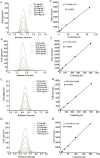Exploration of folate and its derivatives in grains of wheat with different colors
- PMID: 40242474
- PMCID: PMC12000047
- DOI: 10.3389/fgene.2025.1549122
Exploration of folate and its derivatives in grains of wheat with different colors
Abstract
Folate plays essential role in sustaining cell activity, promoting cell growth, and participating in cell division and proliferation. The demand for colored wheat is increasing day by day due to its high content of anthocyanin, iron, zinc, selenium, and other beneficial elements. To investigate the folate content and its derivatives in colored grains wheat, in this study employed a total of 113 wheat varieties (lines) with varying grain colors. The content of four folate derivatives, tetrahydrofolate (THF), 5-methyltetrahydrofolate (5-CH3-THF), 5-formyltetrahydrofolate (5-CHO-THF), and 5,10-methylenetetrahydrofolate (5,10-CH+THF), in grains cultivated under three different growing conditions were quantified using high performance liquid chromatography (HPLC). The results revealed that the four folate derivatives were distributed among wheat varieties exhibiting varying grain colors, with a coefficient of variation (CV) ranging from 15.34% to 20.10%. Among them, Lin 4179 emerged as a high-folate variety with a total content of 76.00 μg · 100 g-1. The contents of 5-CH3-THF and 5-CHO-THF in the four folate derivatives accounted for approximately 70% of the total folate content and exhibited a significant correlation with total folate content. The mean total folate level in purple and blue grains was 61.84 and 60.95 μg · 100 g-1, respectively, which was significantly higher than that in white (41.93 μg · 100 g-1) and red grains (42.40 μg · 100 g-1). The genotypic effect is the main factor affecting total folate content, while environmental factors had less impact. Genome-wide association studies (GWAS) identified four major loci associated with folate content on the chromosomes 1B, 4D and 7A, of which QFac.4D and QFac.7A.1 were stated as novel. The results of this study provide valuable insight into the development and breeding of folate biofortified wheat varieties.
Keywords: QTL; folates content; genetic factor; grain color; wheat.
Copyright © 2025 Tian, Liu, Cheng, Yang, Wang and Wu.
Conflict of interest statement
The authors declare that the research was conducted in the absence of any commercial or financial relationships that could be construed as a potential conflict of interest.
Figures




References
-
- Arcot J., Wootton M., Alury S., Chan H., Shrestha A. K. (2002). Folate levels in twelve Australian wheats and changes during processing into bread. Food Aust. 54, 18–20.
LinkOut - more resources
Full Text Sources

